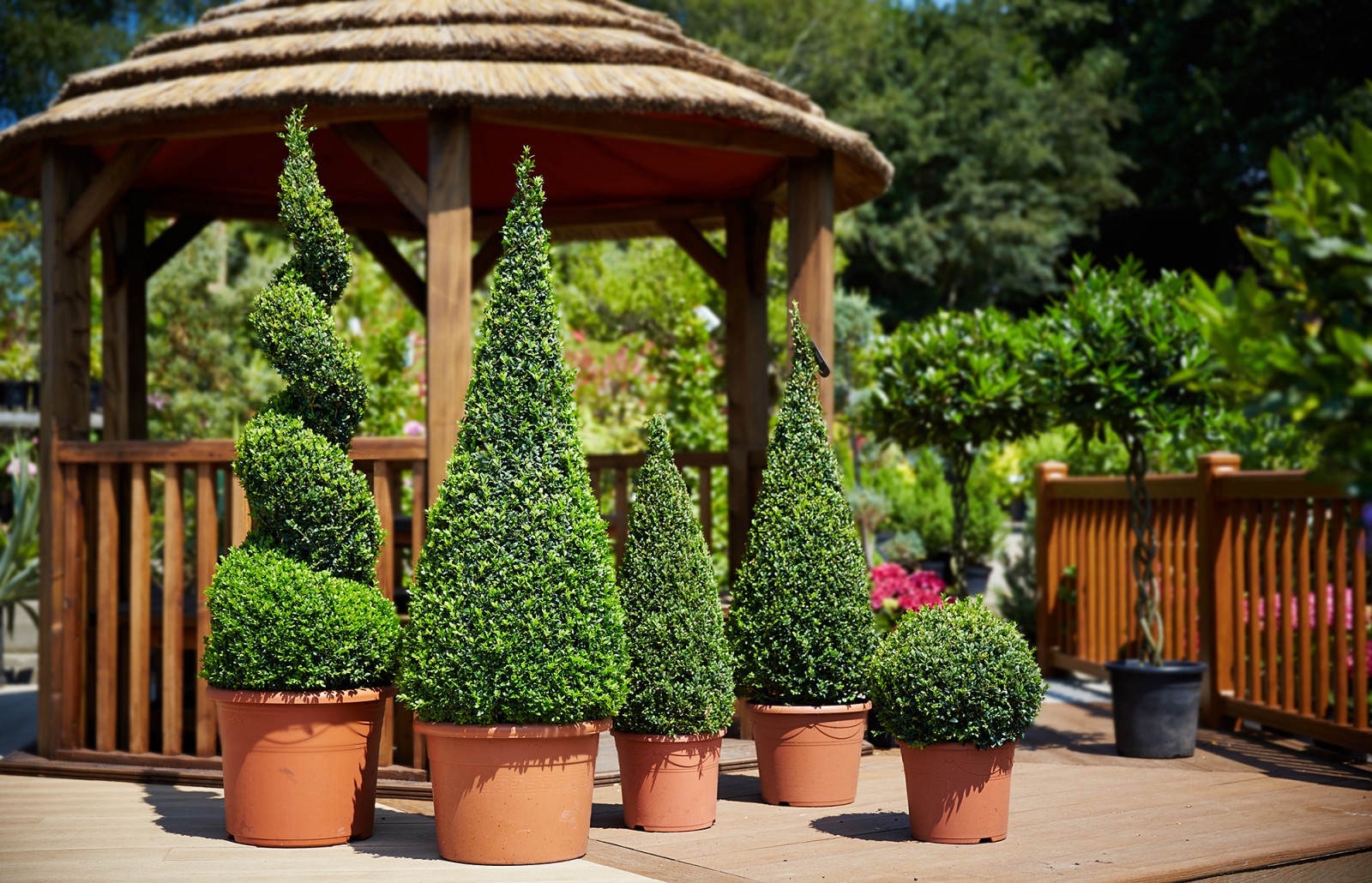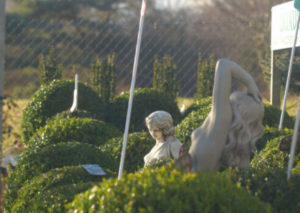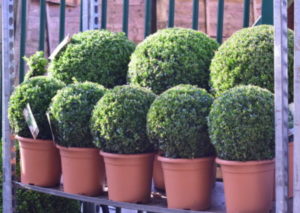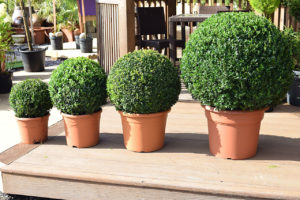

Topiary / Buxus
Capel Cottage is one of the largest stockists of topiary in the area, and offer all shapes and sizes ranging from 15-20cm Buxus Balls up to 120cm balls (upon request). Spirals, Egyptian Pyramids, Lollipops, Bay Trees and Olive Tree standards are also extremely popular.
Bonsai Trees
We also carry stock of Bonsai Trees in tree form and cloud, with trees in excess of 60 years old.
Care and Treatment of Topiary / Buxus Box Blight
Box Blight is well documented in the press and is being seen more and more. Having recently visited and talked with growers in Belgium and Holland, it would seem that the problem there is broad based too, and the disease appears to be widespread. The continental box market is huge and that helps keep prices affordable.
This disease is now widespread in the UK having been first recognised in the mid 1990’s. It affects Buxus sempervirens and its cultivars – these include suffruticosa, variagata, and elegantissima amongst others.
Typically the identifying features are dark brown spots on the leaves and black streaks running along the stems, plants then start to defoliate as the leaf dies and dieback of the plant ensues. The result for many parterres, shrubberies, topiary and knot gardens can be devastating.
A scan from an electron micrograph (image, right) showing Cylindrocladium buxicolae florescence on the leaf surface of Buxus sempervirens. Clearly visible are the clusters of rodlike conidia (spores), conidiophores (the hypha that generate the spores) and club-shaped vescicles.
There are two species of box blight, and both are fungi: Cylindrocladium (C.buxicola) and Volutella (V.buxi). There are some distinguishing characteristics of each but they are broadly similar in their method of action. They usually occur together.
Favourable climatic conditions include both high humidity and dry, and infections can become established within 48 hours in these conditions.
It is a ‘cold’ disease and the spores are not affected by frosts and are only inhibited by temperatures in excess of 30 Celsius. The number of cases of the disease peaks in autumn, particularly between September and November.
Identifying Box Blight
Identification in the early stages can be difficult as the leaf symptoms can be similar to other cultural problems. The spots and streaking are good characteristics to look out for, as are greying leaves for the Cylindroclodium species and pinkish leaves on the Volutella species.
Spreading Box Blight
The disease is spread by a variety of methods. The simplest way of introducing it to your garden is by purchasing diseased plants – or when neighbouring gardens already have the problem.
With the Volutella species of blight, wounds can let the disease into the plant, particularly caused by clipping.
The usual route for C.buxicola is through the stomata on the leaf – these are holes through which the plant transpires – so allowing moisture in. The spores are carried on moisture and thus enter the plant.
The spores can be spread from garden to garden in the soil on your boots, for short distances on animals and insects, and also through water splash.
The spores of the disease are sticky and are able to adhere to potential carriers. It is not easy for the gardener to deal with this problem.
There is a school of thought that suggests there is only one species of blight but it develops in two stages – perfect and imperfect, one stage being more virulent than the other.
Treating Box Blight
The affected areas can be pruned out and all the debris and leaf fall destroyed, but this is by no means a guaranteed cure. As discussed, the spores can easily travel and will survive on fallen leaves and decomposing material for up to 11 months. Also, the act of pruning causes wounds that expose the plant up to further infection. Be sure to disinfect all pruning tools thoroughly.
Keep your plants watered by direct water to the roots and do not spray over the plants.
Fungicides that are generally available to the private gardener are not sufficiently effective, but what can be used are copper-based fungicides that will have some contact action. Thankfully, the horticultural industry does have access to suitable control methods – so the gardener is reliant on the garden centres’ acumen in dealing with infected stock. However any dead leaf matter that escapes the spray is able to re infect plants.
We buy very selectively at Flower Pot Nursery, and apply stringent quality control on all plants that enter the nursery. So far we have not had an instance of blight in our own crops, but it is nevertheless a constant worry, and as such we feel we should share information about Box Blight with our visitors and customers! Whilst we have every confidence that the plants we supply do not have Box Blight, it is impossible for us to guarantee against it.
Alternatives
If you have an established Box Blight problem and are finding it difficult to eradicate the disease, there are alternative small leaved evergreens worth considering. Ligustrum jonandrum is excellent for for topiary, Ilex crenata (right)and Lonicera nitida are all good for hedging and will lend themselves well to clipping.
We currently have a selection of ilex crenata balls in the nursery and it is difficult to tell the difference between this and Box at first glance. Please contact us for any further information and advice.
Here at Flower Pot Nursery we will happily try to help you identify and solve any problems you are encountering with your shrubs and trees. If you would like further advice or information, please don’t hesitate to contact us.





